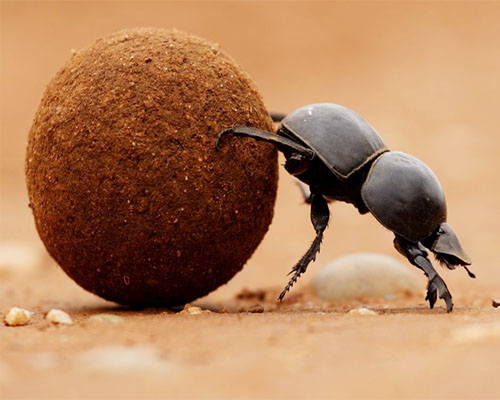The Amazin Dung Beetle
These little beetles are some of the most fascinating insects out here in the bush.
Dung beetles are amazing creatures!

For the whole of winter they have been in a state of torpor waiting for the heat of summer and the first rains to arrive, then bush has started buzzing with the wing beats of these flying decomposers.
They are unique insects that play an important role in maintaining healthy ecosystems. Even their name is very fitting as their life revolves around dung – they literally can’t live without it!
Dung beetles range in size from a tiny 5mm, to a very substantial 50mm and are divided into groups according to how they dispose of the dung. There are four broad categories of dung beetle: rollers, tunnellers, dwellers and stealers. Rollers shape dung into balls and roll them away from the pile, which they then bury to either munch on later or to use as a place to lay their eggs. Tunnellers dive into the dung pile, usually working in a male-female pair, and dig a tunnel beneath it. Dwellers, on the other hand, simply live inside the dung pile. Then there are the stealers – these lazy beetles will just steal the dung balls from the rollers for their own use.
So, why would an insect want to eat dung? Well, when an animal (such as an elephant or a rhino) munches on some tasty grub, there are always parts of the food that pass through its body undigested, and end up in its dung. Its these nutritious bits of undigested food that dung beetles tuck into.
These cool critters may be small, but they are they mighty! The taurus scarab (Onthophagus taurus) – a species of dung beetle – is considered the strongest animal on Earth in relation to body weight to lift ratio. This insect can pull 1,141 times its own body weight – that’s the same as a human dragging six full double-decker buses!
Dung beetles use the polarised light of the sun and the moon to navigate. According to research, there are some nocturnal dung beetles that have been observed navigating using the Milky Way. Currently they are the only known non-vertebrate animal to navigate and orient themselves using this bright stripe of light generated by our galaxy.
The female lays her eggs in the dung ball (referred to at this stage as the ‘brood ball’) and the larvae are left to develop using the dung as sustenance during the metamorphic process.
As you can see, dung beetles are quite fascinating – so be sure to take some time to observe these little creatures the next time you’re on safari!
Please contact us and we will arrange a dream safari for you to experience - An Experience is Priceless
